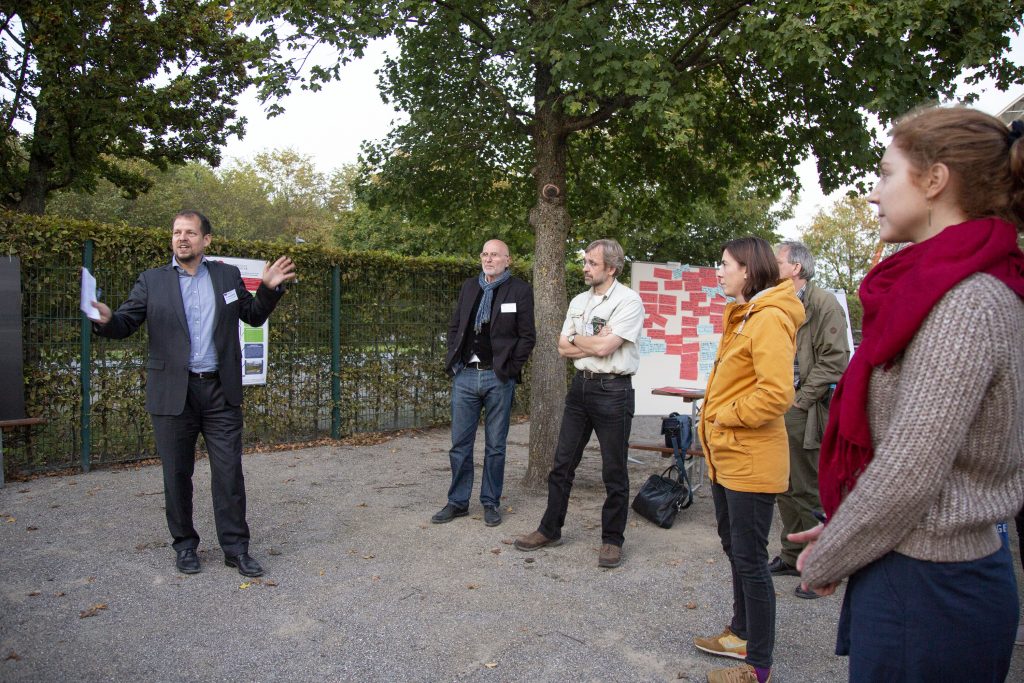
Cities as “natural” problem solvers?
CLEARING HOUSE kicked off a collaborative learning process with first co-design workshop in Gelsenkirchen
What does Gelsenkirchen have in common with the Chinese city of Huaibei?
At first glance, not much. Nevertheless, both cities – along with Barcelona and Krakow, Hongkong and Beijing, among others – were selected as “case study cities” for CLEARING HOUSE (CH), the first Sino-European research project on urban forests. And with good reason: the selected cities are confronted with particular challenges, some of which apply to all the cities, some of which are regional-specific. These challenges range from environmental issues to high unemployment rates, from massive demolition of industrial plants to the opportunities and difficulties that migration entails. All ten cities selected for the CH project (Brussels, Beijing, Leipzig-Halle, Guangzhou, Krakow, Hangzhou, Huaibei, Barcelona, Gelsenkirchen and Xiamen) have a common feature that urban forests, as well as parks and trees in public and private spaces, play an important role in addressing environmental, economic and social challenges.
On 10th September 2020, the first co-design workshop as part of the CH research project took place in the in amphitheatre in Gelsenkirchen, kicking-off the collaborative learning process within CH. Gelsenkirchen – formerly dominated by the coal and steel industry – is challenged in many ways by the economic and social changes of the past decades. In recent years, Gelsenkirchen’s strategy to shape the future of the colourful urban community has focused on prevention, education and participation, as well as the idea of a “learning city” – the combination of inclusive, equal opportunities and good education with “Education for Sustainable Development (BNE)”. This sustainable approach and the transformation of numerous former mining sites (coal mines, coking plants, steelworks) into smaller inner-city parks and the integration of brownfield sites into urban and regional green and forest areas (“Emscher Landschaftspark” of the Ruhr metropolis) make Gelsenkirchen an exciting research object for researchers in the CLEARING HOUSE project.

The main aim of the workshop was to identify and assess challenges and impacts of urban forests as nature-based solutions around six locally relevant topics: climate change, recreation, public health, environmental education, ecosystem services and sustainable (urban forest) management. Organised by several project partners in the CH project, the workshop gathered almost 50 committed actors from local administration, research, civil society (associations, schools and kindergartens) and private-public institutions. The organisation was done by Gelsenkirchen City and Wald und Holz NRW with support from colleagues at LGI Consulting and EFI Bonn.
At the start of the workshop, after welcoming words from Christoph Heidenreich from the City of Gelsenkirchen, Prof. Dr. Georg Winkel (European Forest Institute) introduced the CH project and emphasised the importance of co-design to investigate the state of urban forests in Gelsenkirchen, to identify major challenges relating to urban forests progress and implementation. Furthermore, Prof. Winkel expressed the need to discuss ecological, economic and social impacts of urban forests in Gelsenkirchen with the aim to determine relevant research questions for the CH project.

Fig. 1: Typical misconception of how the roots of a tree grow down rather than flat (Rust, 2020)
Did you know that? That contemporary landscape architecture from the Ruhr area received international recognition at an exhibition at the Museum of Modern Art (MoMA) in New York in 2002. This fun fact and also more critical aspects relating to the planning for urban forests in the Ruhr area were part of the first keynote speech by Prof. Dr. Jörg Dettmar from TU Darmstadt.
The second keynote came from Prof. Dr. Steffen Rust from the Faculty of Resource Management at HAWK Göttingen who gave a presentation on Physiological stress and ecosystem services. In his keynote, he provided important background information on climate change impacts on urban forests and challenges in everyday urban forest planning and management. Many damages on city trees occur because of misconceptions about trees. One example is that the roots of most trees grow flat and not straight down as many people believe.
Other examples of planning and management challenges are related to the selection of trees that are compatible with people that have allergies, the removal of damage caused by storms, pruning that won´t damage the tree, and planning sufficient space for new trees in the design and construction of city streets.
World Cafe
After the inspiring introduction keynotes, a World Café offered the participants the chance to engage and discuss the many different and multifaceted challenges Gelsenkirchen is facing. The discussions during the World Café as well as the whole day was recorded in a graphic presentation below.

Fig. 2: Graphic documentation (Dailleux, 2020)
The discussions brought together different groups of participants for 15 minutes each, thus ensuring different perspectives at the theme tables, naturally these days in compliance with social distancing rules. At the climate change table, the discussion focused on heat-induced mortality of trees in the city and as a result it was debated which species can be planted in the future.
At the sustainable (urban forest) management table participants identified that the communication between different actors in the city could be improved and that building alliances between city departments is crucial for urban forest management.
With regard to public health the biggest challenge is the growing disconnect of citizens and urban green in Gelsenkirchen, the city with the lowest life expectancy in the state of NRW. Moreover, in recent months the importance of urban forests during times of a pandemic came to light and questions relating to the role of forests after the pandemic were discussed.
For the environmental education table one of the central issues is the lack of awareness of the multiple benefits of urban forests, especially for the development and education of children. The planning and management of trees and forests cost money and one of the things discussed at the ecosystem services table was whether to focus on selected ecosystem services rather than all of them.
Lastly, at the recreation table, the participants underlined how important urban forests are as meeting places of different user groups and that a range of well-maintained facilities (huts, benches, sports equipment) are needed. The results of the workshop will inform further research in CH and form the basis for the next Sino-European co-design event in Gelsenkirchen/Bonn/virtually at the beginning of 2021.


Photos of the co-design workshop were taken by Rosa Castañeda
Authors: Dennis Roitsch, Gesche Schifferdecker from European Forest Institute
EFI provides forest-related knowledge around three interconnected and interdisciplinary themes: bioeconomy, resilience and governance and is a CLEARING HOUSE partner.
